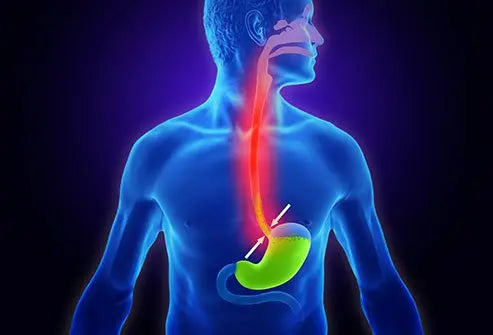
Why Do I Have GERD After Taking GLP-1 (Ozempic and Semaglutides)?
|
|
Time to read 4 min
|
|
Time to read 4 min
GLP-1 receptor agonists like Ozempic and Wegovy have changed how we manage type 2 diabetes and obesity. But for some people, they trigger a less welcome side effect: GERD. GERD, or gastroesophageal reflux disease, is a chronic condition in which stomach acid repeatedly flows back into the esophagus. This reflux can lead to symptoms such as heartburn, regurgitation, bloating, and discomfort after meals.
In this article, we explore why GLP-1 medications can cause GERD and provide strategies to help manage it without interrupting your treatment.
Disclaimer: The information provided in this blog post is for general knowledge and informational purposes only, and does not constitute medical advice. Always consult with a qualified healthcare professional before making any decisions about your health or treatment. If you experience persistent or severe acid reflux, seek medical attention immediately.
GLP-1 drugs (GLP-1 receptor agonists) are designed to improve blood sugar control, support weight loss, and slow gastric emptying. Common examples include semaglutide (Ozempic, Wegovy). While these effects are beneficial for metabolic health, they can also lead to GERD in some individuals.
GLP-1 drugs delay the rate at which food leaves your stomach, a major reason they curb appetite and control blood sugar. But when food stays in the stomach longer, it can cause increased pressure, leading to reflux symptoms and persistent GERD, especially after meals.
As the stomach remains full for longer due to delayed gastric emptying, pressure builds within the gastric cavity. This pressure can push stomach contents upward, particularly in individuals with pre-existing GERD or reduced esophageal tone. The result is a higher risk of reflux symptoms such as heartburn and regurgitation, especially after meals or when lying down.
GLP-1 medications suppress appetite. As a result, some people eat fewer meals per day but consume larger portions at once. These larger meals create more pressure in the stomach, heightening the likelihood of acid reflux and worsening GERD symptoms.
Fortunately, many people can control GERD symptoms through simple lifestyle modifications and targeted symptom management, without having to discontinue their GLP-1 medication.
Eat smaller, slower meals, ideally spread throughout the day.
Avoid eating within 2-3 hours of lying down.
Refrain from drinking large amounts of fluid during meals.
This approach reduces pressure on the stomach and minimizes acid reflux episodes.
Certain foods are more likely to worsen GERD during GLP-1 treatment. These may include:
Citrus fruits and juices
Tomato-based sauces
Chocolate
Fried or fatty foods
Carbonated beverages
Caffeinated drinks
Peppermint
Instead, focus on:
Lean proteins (chicken, fish, tofu)
Non-citrus fruits (bananas, melons)
Cooked vegetables
Oatmeal or whole grains
If you're unsure what your triggers are, consider keeping a food and symptom diary to track your reactions over time. You can also take Claisen’s free quiz for personalized insights into your gut health.
Avoid reclining or lying down for at least 2-3 hours after eating, as this gives gravity time to assist digestion and prevents acid from moving upward into the esophagus.
If acid reflux occurs at night, raise the head of your bed by 6-8 inches or use a wedge pillow. Elevation helps keep acid in the stomach, particularly if delayed gastric emptying is involved.
Some people find GERD symptoms are worse when GLP-1 doses are taken on an empty stomach or close to large meals. With guidance from your provider, you may benefit from:
Changing the timing of your injection
Slowing your dose escalation
Adjusting your mealtime structure
Over-the-counter (OTC) and prescription drugs are available to treat GERD that work either by suppressing the production of stomach acid or neutralizing stomach acids. Common options include:
Calcium carbonate (e.g., Tums)
Alginate-based agents (e.g., Gaviscon)
H2 blockers (e.g., famotidine)
Proton pump inhibitors (PPIs) (e.g., omeprazole)
Important: Always consult your prescribing physician before adding any medication, as drug interactions and timing (especially with semaglutide) need to be carefully managed.
GERD (gastroesophageal reflux disease) is a common side effect of GLP-1 medications due to slowed gastric emptying and increased stomach pressure.
Symptoms include heartburn, regurgitation, and bloating, especially after meals or at night.
Managing meal size, timing, and food choices can significantly reduce GERD episodes.
Talk to your provider before adding antacids or acid-reducing medications.
Ready for personalized relief for acid reflux? Complete Claisen's gut health quiz to identify your unique reflux triggers and receive evidence-based recommendations tailored to your digestive profile.
Yes. While not everyone experiences it, GERD is a recognized gastrointestinal side effect of GLP-1 receptor agonists like semaglutide.
Not usually. With the right changes to your eating habits and medical guidance, most people can manage GERD and continue treatment.
Yes. Many GI symptoms, including acid reflux, improve after 4-6 weeks as the body adapts to slower gastric emptying.
Yes, but only under the direction of your healthcare provider. Acid-suppressing medications can be helpful, but their timing and compatibility with your treatment plan need to be considered.

